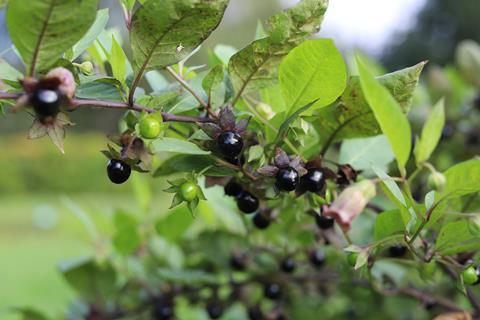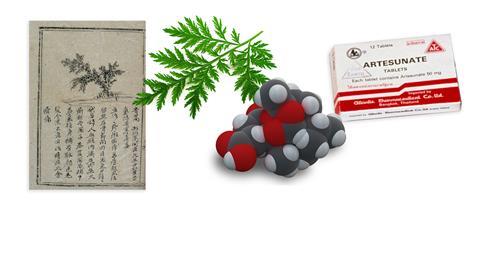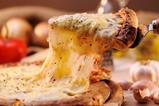How traditional remedies become lifesaving drugs
In 1967, the People’s Liberation Army of China began a top-secret program to support soldiers fighting in the Vietnam war. The North Vietnamese troops were jungle fighters and were losing thousands of troops to malaria, a mosquito-borne parasite that had become resistant to most drugs. The Chinese programme, code named Project 523, aimed to find a cure.
At first, the mission was unsuccessful, screening more than 240,000 compounds to try to find a cure. Then, one of the investigators, the chemist Tu Youyou, decided to look at old Chinese folk remedies. In a book from 340 AD, she found a story about an old folk remedy containing the plant Artemisia annua – known as qinghao – used for ‘intermittent fevers’, one of the symptoms of malaria. Using her chemical expertise, Youyou realised the recipe was wrong – boiling the herb would destroy the active ingredient – but it set her on the right path. In 1979, she published her results, revealing a new antimalarial drug to the world: artemisinin.
The story is just one example of how chemists have used the medicinal properties of plants – and the folklore that goes with them – in the fight against illness and diseases that kill millions every year.
In your class
Many of our modern medicines have their roots in traditional remedies. Use the context of this article to get post-16 learners to synthesise organic products such as aspirin in the lab by linking it back to the active ingredients in willow bark and meadowsweet flowers. Could the next miracle cure be derived from the world of natural remedies, and what roles will future chemists play in improving and modifying them for licensed medicinal use?
Traditional acceptance
Medicinal plants have been used around the world for centuries and continue to be used today; there are around 26,000 plant species with a documented medical use and some cultures rely on them heavily. In South Africa, for example, around 27 million people are thought to be solely relying on traditional medicines. In more conventional medicine, it’s estimated that somewhere between 40% and 70% of all medicines in use today come from traditional or folk remedies, says Colin Wright, a researcher specialising in pharmacognosy (medicines from plants) at the University of Bradford. It all depends, he says, on what you mean by ‘come from’. ‘Some drugs extracted directly from plants have been used traditionally. Good examples include morphine and codeine from the opium poppy, quinine from Cinchona bark and galantamine, from daffodils and snowdrops.’ But even more stem indirectly from modifying these so-called natural products.

For example, diamorphine (better known as heroin) is an incredibly powerful analgesic but is made from morphine. Another, hopefully more familiar example, is aspirin, which comes from salicin, a molecule found in the bark of willow trees. Even plants found in UK gardens that are usually poisonous – such as foxgloves or deadly nightshade – can produce useful remedies. Foxgloves are a source of digoxin, a molecule that interacts with the heart’s sodium levels, altering its stroke rate and blood pressure, saving patients with heart failure or an abnormal heartbeat. Nightshade, meanwhile, contains atropine, a tropane alkaloid poison that acts on the body’s parasympathetic nervous system, but can also be used to treat heart conditions, or dilate the pupils in an eye exam. Nightshade’s Latin name, Atropa belladonna, comes from the fact Italian girls used to deliberately poison themselves with the plant to make their pupils larger, to appear more attractive.
Folk remedies don’t always come straight from plants. ‘Many drugs not directly from natural molecules are based on compounds from traditional remedies,’ Colin explains, highlighting that there can be wisdom in old wives’ tales and folk descriptions of how to prepare certain plants. ‘The aim here is to improve the natural product, for example by reducing toxicity and side effects, increasing its effectiveness, increasing its duration of action, or improving its oral absorption [when you take it].’
Prize-winning science
This doesn’t mean all traditional remedies work, of course. ‘It’s very difficult to predict what might become a successful, licensed medicine,’ Colin says. In the UK and Europe, traditional medicines have been a grey area of medicines legislation – they can be approved for sale on the market without proving they work, as long as clinical studies prove that they are safe and won’t hurt patients. It’s a problem that, in the past, has led to some effective medicines being overlooked precisely because of where they came from.
‘Artemisinin could be a good example here,’ Colin says. ‘Initially, an extract of the plant was found to be active against malaria in mice and this led to isolation [of the compound] in China. For political reasons, it took some time before that information became available in the West – not helped by the fact that Western scientists did not believe Chinese scientists could have discovered a potent antimalarial drug!’
‘The study of natural product remedies is only in its infancy’
The story of artemisinin didn’t end with Youyou’s discovery. Instead, Western scientists tried to discover their own source of the mysterious qinghao plant to determine if it could be used as an antimalarial, ignoring Youyou’s papers. For years, US researchers at the Walter Reed Army Institute of Research in Washington DC searched the globe for a sample of the mystery plant so they could perform their own research. In 1985, much to their embarrassment, they realised that they knew the plant by a different name – sweet wormwood. It was a weed that grew on the banks of the Potomac river, less than five miles from their laboratory.
-

Download this
Research and presentation activity, for age range 16–18
In this group activity, learners will research the development of aspirin from an ancient cure using willow bark or meadowsweet plants to a modern preventative treatment for heart attacks. They will then choose to communicate their findings as a poster, presentation or video.
Download the student instructions as MS Word or PDF, the additional information as MS Word or PDF and a timeline of the development of aspirin as MS Word or PDF.
Download the teacher notes including peer assessment criteria and extra information on alternative medicines as MS Word or PDF.
Download this
Research and presentation activity, for age range 16–18
In this group activity, learners will research the development of aspirin from an ancient cure using willow bark or meadowsweet plants to a modern preventative treatment for heart attacks. They will then choose to communicate their findings in a poster, presentation or video.
Download the student instructions, additional information, a time line of the development of aspirin and the teacher notes, including peer assessment criteria and extra information on alternative analgesics.
Download the resources from the Education in Chemistry website: rsc.li/3OfHQKu
The Americans confirmed the Chinese work was genuine and that artemisinin was a powerful weapon in the fight against one of the deadliest diseases in history. Today, artemisinin is the first-choice medicine for treating malaria around the world and Youyou’s discovery is credited with saving thousands, perhaps even millions, of lives. It was such a major contribution that, in 2015, Youyou won the Nobel prize in physiology or medicine for the discovery.
Chemical clues
Youyou’s success and recognition have reinvigorated research into an area scientists had begun to move away from. ‘The study of natural product remedies is only in its infancy,’ says Geoff Rayner-Canham, a chemist at the Memorial University of Newfoundland, Canada, who has previously worked with researcher and indigenous Canadian Chaim Christiana Andersen to explore Inuit remedies. He points out there are major champions of natural products around the world. More importantly, many of these folk remedies are currently in use. ‘Inuit still rely on traditional medicines. When you’re in the middle of the Arctic, there’s no branch of Boots just around the corner,’ Geoff laughs.
One of the particular treatments used by Inuit tribes is the puffball fungus, Geoff says, which is used to treat cuts and prevent wound infection. ‘They collect it in the summer and carry it with them. They say it works superbly and researchers have already started extracting bioactive compounds. In fact, for every remedy [the Inuit] shared with me, there was already a paper looking at their active ingredients.’
Traditional remedies, such as the Inuit’s, are gradually vanishing as the knowledge has stopped being passed down through the generations
This highlights another key role so-called traditional medicines can play in our search for the next blockbuster drug, such as Youyou’s artemisinin. While the remedies themselves might not be the most effective, they can signpost us to other, more effective treatments and give us clues as to what medicines might be lurking in different species of plants.
This is where chemists can step in, says Melanie-Jayne Howes, a senior research leader at the Royal Botanical Gardens, Kew, in London. Melanie-Jayne’s own research has looked at taking chemically complex molecules from plants and using them for treatment, including vincristine, a very potent anti-cancer drug, which was found inside the Madagascar periwinkle. One of the challenges, though, is working out which treatments are real and which are dead ends. Melanie-Jayne has also explored traditional remedies for malaria in Latin America and found more than 1000 different plant species mentioned by local tribal groups as a possible cure.
More resources
- Why might budding medics need to study post-16 chemistry to pursue medicine at university? Find out with this article and resource series connecting post-16 topics with future study pathways.
- Use this class practical to produce aspirin in a microscale esterification reaction using phosphoric acid as a catalyst.
- Show your students this interview about what it takes to lead a team of 30 chemists researching new medicines.
- Reflect on the science and societal views surrounding drugs and their development with this critical thinking and research task.
More resources
- Use this article and resource series connecting post-16 topics with future study pathways to start a class conversation about why budding medics need to study post-16 chemistry to pursue medicine at university: rsc.li/41Icv6l
- Engage students with a class practical producing aspirin in a microscale esterification reaction using phosphoric acid as a catalyst: rsc.li/3BDlf36
- Show your students this interview about what it takes to lead a team of 30 chemists researching new medicines: rsc.li/3IkRTtX
- Get students to reflect on the science and societal views surrounding drugs and their development with this critical thinking and research task: rsc.li/41PjBpJ
This is why a key role for chemists researching traditional medicines isn’t just in looking into the past, but also looking at newly discovered plants and working out if they can contribute to our medical arsenal. According to Kew, in 2019 alone, botanists recorded 1942 new plants and 1886 new fungi. These included a host of flowers from all around the world, from species that are known to have medicinal properties and could lead to potential medicines. Just a few examples are Eryngium arenosum from Texas, US, which could be used to treat inflammation or scorpion stings; Artemisia baxoiensis, a potential antimalarial from the mountains of Tibet; and three entirely new Oenothera plants, or evening primrose, which were found in Italy, Poland and a Pacific island – all of which could potentially treat eczema and psoriasis.
Forgotten knowledge
While there is an opportunity, there is a danger, too. Overharvesting and trade in bulbs, bark and roots can destroy entire ecosystems, as up to 86% of harvesting kills the entire plant. Currently, 723 medicinal plant species are categorised as threatened – usually because of agriculture and use, but increasingly by growing cities, invasive species and climate change. In addition, the traditional remedies, such as the Inuit’s, are gradually vanishing as the knowledge has stopped being passed down through the generations.
For Colin, it’s never been more important for scientists to record and understand how medicinal plants can be used today in case another treatment like artemisinin is forgotten. ‘Traditional knowledge is being lost,’ he says. ‘To some extent, this is a race against time.’
Top image, clockwise from left: A page with a painting of sweet wormwood (qinghao, Artemisia annua) from Diannan bencao tushuo (The Illustrated Yunnan Pharmacopoeia), originally written in China by writer Lan Mao in the 14–15th century (Wellcome Collection. Public Domain); a photo of sweet wormwood © Scisetti Alfio/Shutterstock; a molecule of artesunate © Ella Maru/Science Photo Library/Getty Images; a photo of malaria treatment artesunate © Andy Crump, TDR, WHO/Science Photo Library
Story by Kit Chapman, an award-winning science journalist. Resource by Dorothy Warren, an independent science education consultant















No comments yet